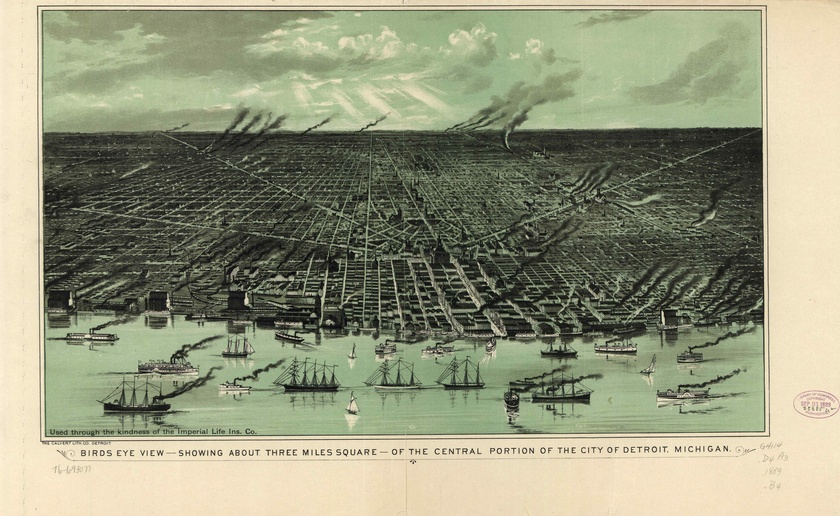Detroit’s population in the 1810s was less than 800 — but four decades later, it was a hub of commerce, primarily focused around food and tobacco. In 1880, the city had grown to a population of 116,340, and by the 1920s, the nearly 1 million inhabitants made it the fourth largest city in the country. Its economy was almost totally focused on industry, bolstered by the defense work of the first World War. Henry Ford’s Rouge River and Highland Park plants were in full swing, and GM was on the rise.
Along with this change in purpose of the city came a change in the way people interacted in daily life. Where 1880 Detroit was a city primarily built on national and ethnic origin, post-WWI Detroit was structured around class and production. In part the story of changing communities in the city, this shift meant the places people lived, worked, and played changed.
1880s Detroit
In 1880, the city’s largest employers were clothing, lumber, tobacco, shipbuilding, and food, each claiming at least a thousand employees spread across 60-100 small establishments in each category. (Hazen Pingree’s boot and shoe factory was one of them).

Nearly a third of the population was German, a fifth American, and the rest mostly white. Employment was structured mostly by race: significantly more native-born Americans had white-collar jobs than any other ethnic group. Ethnic groups also tended to center around a particular type of work; the Germans, tobacco; Americans, schools and printing, for example.
Because of low density in the city, there was plenty of room to expand. Each new community has its own story of finding mild acceptance — or creating its own built environment in the city. Poles arriving in the late 1800s settled far towards the easter and western edges of the city. Germans in Detroit settled in several distinct areas. Russian Jews built synagogues on the east side of the city. Native-born Americans tolerated British and Canadian neighbors. Only 1.5% of the population was Black.
Each area had a distinct character, as immigrants used the techniques and traditions they brought with them. Some houses were brick, others (primarily the Irish) used wood frame construction.
1900s Detroit
Land use patterns changed between the 1800s and early 1900s. Neighborhoods became entirely residential, and commercial and industrial activities started to separate.
New construction, as before, was primarily around single-family housing. Options for individual workers were slim, but most workers found family housing and individual properties, conditions that made life in the city much easier than the packed tenements of New York City and Chicago. This background contributed to long history of a shortage of affordable and rental properties in the city. By percentage, significantly more immigrants owned their own homes than native white Americans, making home ownership a trait of ethnicity rather than social class.
In some cases, especially in Polish neighborhoods, homeowners rented parts of their houses to other families of the same ethnicity. This unofficial system helped families be able to afford housing and pay their debts
The neighborhoods shared by African-Americans and Jews on the East Side remained structurally integrated, with shops and entertainment mixed with high-density, overcrowded multi-family housing. Because of extreme discrimination in real estate, it would remain that way by necessity until the onset of urban renewal in the late 1940s.
1920s and the Depression
 Housing in Detroit in 1929. Photo courtesy Virtual Motor City
Housing in Detroit in 1929. Photo courtesy Virtual Motor CityDetroit’s nearly 1 million inhabitants (more than that, if the outlying towns and unincorporated areas are included) made the city the fourth largest by 1920. The bounds of Detroit had also grown to include nearly 80 square miles, defining a sprawling, low-density city. With this growth came a change in the social structure of the city. New jobs in manufacturing decreased the number of immigrants and increased the number of single men, creating new challenges for housing and communities.
The new residents were mostly native-born Americans, both black and white. The percentage of immigrants in the city had decreased to about 30% from a peak of 47% in 1850. The proportion of workers — men between 25 and 29 years old — was double the national average. Manufacturers contributed to the decline in ethnic ties by forming the Detroit Americanization movement.
Hundreds of black workers and families were arriving each day in 1920; thousands each week. Because African-Americans were the last of a long succession of ethnic groups to join Detroit on a large scale, they faced a hostile population in a city already lacking for housing.
To accommodate this shift, the city filled in. Industries small and large remained scattered around the city, and no particular area was considered an industrial district. Heavy industry and large auto plants were now concentrated in a crescent around the city.
Sources
Zunz, Olivier. The Changing Face of Inequality: Urbanization, Industrial Development, and Immigrants in Detroit, 1880-1920. University of Chicago Press, 2000.


